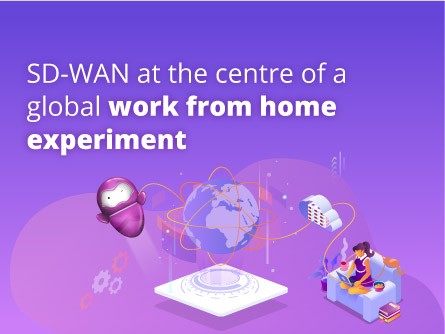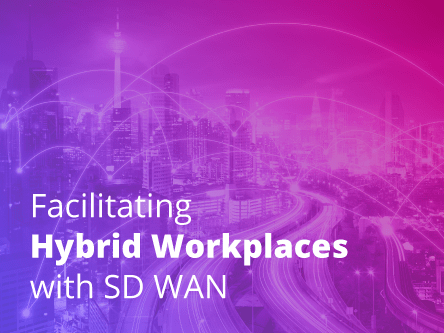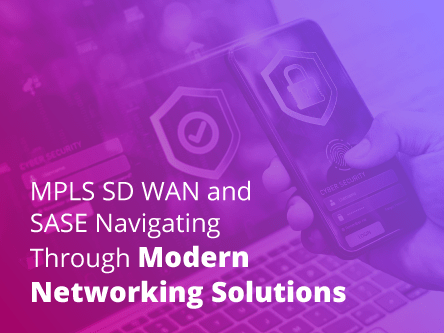Over the last few months, companies globally have activated their business continuity plan (BCP) to enable remote working in response to the COVID-19 pandemic.
Many of these companies have large workloads on the cloud, making it absolutely necessary for staff to access these data and cloud applications wherever they are connected from.
In 2019, growth in adoption of software-defined wide-area networking (SD-WAN) was driven by enterprises seeking cost-reductions, but that’s changing.
SD-WAN is critical for enterprises with distributed workforce or multiple branch offices. And this is more important than ever before as the corporate world is now at the mercy of a fast pandemic.
On the bright side, many of these businesses have already adopted SD-WAN over the last few years.
The SD-WAN market reached approximately $1.5 billion revenue in 2019, and is set to reach almost $2.2 billion by 2020 according to research by Futuriom. Without a doubt, the significance of SD-WAN will rise exponentially during this period.
Why SD-WAN for remote workers?
SD-WAN provides flexible, scalable and secure connectivity that’s crucial for companies managing access between offices and multiple clouds in a hybrid environment.
Not only is SD-WAN faster to deploy, it allows better visibility and centralised management of the network. Remote workers accessing company resources, such as cloud-based collaboration tools and other software-as-a-service (SaaS), can be supported by SD-WAN.
Most would compare internet-based Virtual Private Network (VPN) to SD-WAN.
While VPN may triumph in terms of costs for a simple setup with a few sites, the performance, reliability and security of SD-WAN are the biggest benefits.
Above all, SD-WAN can be used to manage multiple connection types from Multiprotocol Label Switching (MPLS) to internet VPN. We have discussed this widely in our SD-WAN e-Guide.
With the widespread business use of cloud applications and infrastructure, SD-WAN can enable remote workers to quickly and securely access them from their homes.
According to an article by Telegeography’s Greg Bryan, WAN managers would tend to agree that SD-WAN made office closures much easier to deal with and it is perfectly applicable once things return to normal.
The differentiators of SD-WAN
Enterprises will have to make a conscious effort to ensure that staff across different offices and those working remotely are collaborating effectively.
Here’s how SD-WAN can support that:
- Owned Infrastructure for Reliability and Control
By choosing an SD-WAN solution that leverages a global backbone network, enterprises benefit from increased network performance and the ability to seamlessly connect to data centres and cloud service providers, like Google Cloud Platform, across the globe. Unlike SD-WAN that is only deployed as a software overlay to existing infrastructure, an owned infrastructure can offer enterprises a rock solid and predictable foundation for connecting their applications. - Integrated Security for Simplicity and Efficiency
Integrated security offers enterprises an ultra-secure SD-WAN without needing to manage multiple vendors and services. They can easily configure network firewalls, encryption and security protocols from the same portal without needing to manage additional security solutions. It increases the speed and agility of an enterprise’s operations and removes the complexity from securing access across the WAN. - A Simple and Seamless Service Experience
User experience is critical. SD-WAN has to be easy to use and accessible from wherever the IT team operates. A good SD-WAN portal will allow seamless configuration and control of the WAN, with intuitive UX and UI, making it as simple as using any other cloud-based platforms. - Analytics and Monitoring Tools for Optimising Operations
Deep analytics and monitoring tools can be used to effectively plan, manage and forecast an enterprise’s network needs.A key differentiator in SD-WAN is a tool that provides enhanced tracking and visibility for IT teams to monitor their WAN performance. With real-time insights into their network, they can continually shape their network environment accordingly and optimise their operations. - Service Threading for an All-In-One Solution
Enterprises with various needs can benefit from a service provider that can thread together multiple network services into a single solution. By opting for a one-stop-shop that not only provides SD-WAN, but also other services including dedicated internet access (DIA), remote peering at internet exchanges, data centre interconnect (DCI) and direct cloud connection, enterprises can reduce costs, simplify network management and automate their services. - Support from Software and Network Experts
Enterprises should look for SD-WAN providers that have expertise in both software and networking – software knowledge alone isn’t enough.By selecting a service provider with network experts, enterprises gain the support of qualified engineers that can deal with any issues as quickly and efficiently as possible. Service providers with strong telecoms heritage are also likely to have established relationships with network service providers across the globe, enabling enterprises to scale quickly and efficiently.
These differentiators will only grow in importance as enterprises face unprecedented challenges in a fast-digitalising world.
Enterprises have to prioritise simplicity, performance and security to ensure their success and make their network transformation as easy and risk-free as possible.
The COVID-19 pandemic may have changed the ways some businesses view their network.
For most, the priority is keeping the lights on, while some will have to review their IT operations and be forced to make the appropriate changes to keep afloat during these challenging times.







